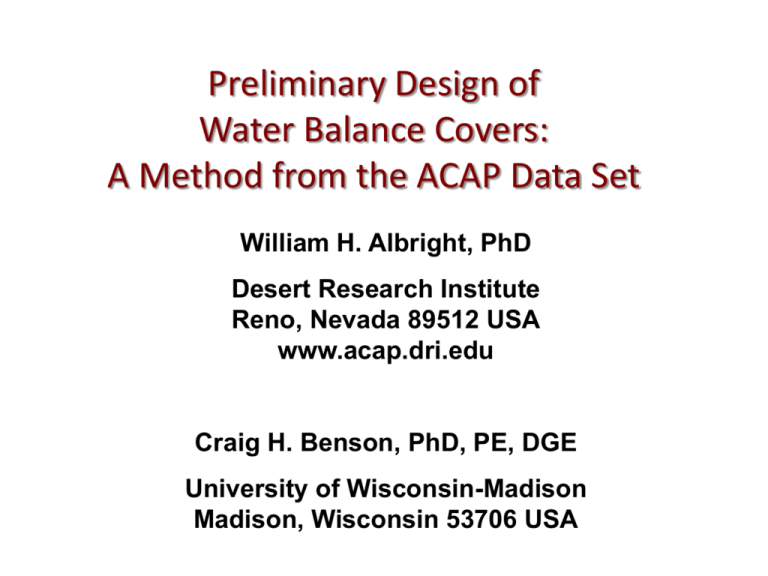PowerPoint - CLU-IN
advertisement

Preliminary Design of Water Balance Covers: A Method from the ACAP Data Set William H. Albright, PhD Desert Research Institute Reno, Nevada 89512 USA www.acap.dri.edu Craig H. Benson, PhD, PE, DGE University of Wisconsin-Madison Madison, Wisconsin 53706 USA Water Balance Covers: Sponge Concept Precipitation Evapotranspiration Infiltration “Sponge” Percolation if S > Sc S = soil water storage Sc =soil water storage capacity ACAP Site Locations Boardman, OR Polson,MT Helena, MT Omaha, NE Cedar Rapids, IA Sacramento, CA Altamont, CA Monterey,CA Apple Valley, CA Albany,GA Monticello, UT ACAP: The Field Program • Nationwide: 12 sites, 8 states • Large (10 × 20 m) drainage lysimeters • Conventional technology – Composite – Clay barrier • Alternative technology – Water balance – Capillary barrier Water Balance Covers Evaluated by ACAP Helena, Polson, MT MT Boardman, OR Altamont, Apple Monticello, CA Valley, CA UT Marina, CA Albany, GA Marion, IA Omaha, NE Sacramento, CA 0 mm 300 600 900 1200 1500 1800 2100 Compost / Soil Mix Soil-Gravel Admixture 2400 Topsoil Gravel 2700 Storage Layer Clean Sand 3000 Compacted Vegetative Cover Interim Cover Silty Sand Vegetation (Hybrid-Poplar Trees with a grass understory) Vegetation (Grass) Vegetation (Grasses, forbs, and shrubs) Full-scale equipment and methods Undisturbed sample to capture as-built soil properties Water content probe to monitor soil water status Data Summary Maximum Average Site Precip. (mm) Perc. (mm) Year Precip. (mm) Perc. (mm) Albany, GA 1380.2 218.3 4 1202.3 109.2 Altamont, CA 498.6 139.3 4 379.7 44.8 Apple Valley, CA 272.0 1.8 3 167.4 0.5 Boardman, OR (Thin) Boardman, OR (Thick) 210.8 0.0 0.0 3 181.4 0.0 0.0 Cedar Rapids, IA 898.4 366.1 4 930.0 207.3 Helena, MT 351.5 0.1 5 272.4 0.0 Marina, CA 406.9 82.4 4 462.8 63.3 Monticello, UT 662.9 3.4 5 387.0 0.7 1 732.5 Omaha, NE (Thin) Omaha, NE (Thick) 612.4 101.0 57.9 Polson, MT 308.1 0.4 349.1 Sacramento, CA (Thin) 361.2 108.4 - Sacramento, CA (Thick) 455.7 8.5 3 Underwood, ND 585.2 9.4 1 422.0 384.1 56.1 27.0 0.2 54.8 2.7 7.1 ACAP: The Products • Nation-wide field-scale data set for composite, compacted clay and water balance covers • Measured changes to soil hydraulic properties due to pedogenesis • Published results – www.acap.dri.edu • 25 workshops • A new method for feasibility assessment and preliminary design How Do Water Balance Covers Work? • Natural water storage capacity of finer textured soils • Soil water storage typically seasonal • Water removal by evaporation and transpiration • Percolation occurs when soil water storage exceed total storage capacity • Key: Need to know required storage, Sr. • We always knew how to store water, we did not know how to determine ‘how much’ • The ACAP data set from a nation-wide network of field-scale test sections provides a method to determine Sr • The method is based on data, not estimates from models 2000 500 Total storage capacity = 300 mm Requred storage capacity (S ) 400 r 1500 300 1000 200 500 Soil Water Storage Precipitation 100 Percolation 0 0 7/1/00 10/27/00 2/22/01 6/20/01 10/16/01 2/11/02 6/9/02 10/5/02 1/31/03 Cumulative Percolation, Soil Water Storage, and Surface Runoff (mm) Cumulative Precipitation and Evapotranspiration (mm) Water Balance Covers: How They Function We Answered 2 Questions: When & How Much r,m Net Monthly Water Accumulation (S ) (mm) 1. Determine when water accumulates. 2. Define how much water accumulates. 300 (a) No Snow & Frozen Ground 200 100 0 -100 -200 -300 S r,m = -0.0014 P m 2 + 0.899 P - 18.06 m 2 R = 0.59 Albany Altamont Apple Valley Marina Sacramento (thin) Sacramento (thick) 0 100 200 Monthly Precipitation during Fall-Winter (P m, FW 300 ) (mm) Example: for fallwinter months at sites without snow, water accumulates in the cover when the monthly precipitation (Pm) exceeds 21 mm, on average. Thresholds for Water Accumulation Examined P, P/PET, and P-PET as indicators of water accumulation and found P/PET threshold works best. Data segregated into two climate types (with & without snow and frozen ground) and two periods in each year (fall-winter and springsummer). Water accumulates when P/PET threshold exceeded. Climate Type Season Threshold No Snow & Frozen Ground Fall-Winter P/PET > 0.34 SpringSummer P/PET > 0.97 Snow & Frozen Ground Fall-Winter P/PET > 0.51 SpringSummer P/PET > 0.32 Fall-winter = September - February Spring-summer = March - August How Much Water Accumulates? 1. Use water balance approach: ΔS = P – R – ET – L – Pr Δ S = change in soil water storage R = runoff P = precipitation ET = evapotranspiration L = lateral internal drainage (assume = 0) Pr = percolation 2. ET is unknown, but is a fraction (β) of PET: ET = β PET 3. R, L, and Pr can be lumped into losses (Λ) Simplify to obtain: ΔS = P – β PET – Λ 4. Equation used to compute monthly accumulation of soil water storage if P, PET, β, and Λ are known. Parameters for Water Accumulation Equation Δ S = P – β PET – Λ Climate Type No Snow & Frozen Ground Snow & Frozen Ground Season β (-) Λ (mm) Fall-Winter 0.30 27.1 SpringSummer 1.00 167.8 Fall-Winter 0.37 -8.9 SpringSummer 1.00 167.8 0 Two sets of β and Λ parameters (fall-winter & springsummer) for a given climate type. Monthly Computation of Required Storage (Sr) Sr Pm FWPETm FW 6 m 1 Pm = monthly precipitation PETm = monthly PET Fall-Winter Months Pm SSPETm SS 6 m 1 Spring-Summer Months Include only months that exceed P/PET threshold If ΔSm < 0, set ΔSm = 0 βFW = ET/PET in fallwinter βSS = ET/PET in springsummer ΛFW =runoff & other losses in fall-winter ΛSS = runoff & other losses in springsummer Example: Idaho Site (snow & frozen ground) For months below threshold, set ΔS = 0 Δ S = P – 0.37*PET (Fall-Winter) β = 0.37, Λ = 0 Store 97 mm for typical year, 230 mm for wettest year Example: Texas Site (no snow & frozen ground) For months below threshold, set ΔS = 0 ΔS = (P – 0.37*PET)-27 (Fall-Winter) β = 0.3, Λ = 27 Store 188 mm for 95th percentile year, 548 mm for wettest year Predicted and Measured Sr 800 Max. Computed Required Storage (mm) Monthly P/PET Bias = 15.6 mm Standard Error = 43.1 mm 600 Good agreement between computed and measured required storage. -50 mm -100 mm Albany Altamont Apple Valley Boardman (thin) Boardman (thick) Cedar Rapids Helena Marina Monticello Omaha (thin) Omaha (thick) Polson Sacramento (thin) Sacramento (thick) Underwood 400 200 0 +50 mm 0 200 400 600 Max. Measured Required Storage (mm) 800 Conclusion: A Two-Step Method for Design of Water Balance Covers 1. Preliminary design: estimate required thickness using ACAP approach based on a robust, nation-wide field data set 2. Refine the design with numerical simulations to evaluate: • Important design parameters • “what if?” assessments 3. Read the book







